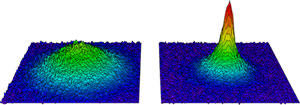
False color images of the molecular Bose-Einstein condensate forming. Left—A cloud of gaseous fermionic potassium cooled to 250 nanoKelvin and paired into bosonic molecules. Right—The same experiment starting at 90 nanoKelvin where the molecules collapse into a Bose-Einstein condensate. In both images higher areas indicate a greater density of atoms.
A super-cold collection of molecules behaving in perfect unison has been created for the first time from a sea of "fermion" atoms by researchers at JILA, a joint institute of the Department of Commerce's National Institute of Standards and Technology (NIST) and the University of Colorado at Boulder (CU-Boulder).
Fermions are a class of particles that are inherently difficult to coax into a uniform quantum state. The ability to meld fermions into this state—a soup of particles that acts like one giant, super molecule—may lead to better understanding of superconductivity, in which electricity flows through certain metals with no resistance.
The work was described in a paper posted November 7 on the informal physics archival Web site at http://arxiv.org and will be published online by the journal Nature on November 26. Researchers Deborah S. Jin of NIST and Markus Greiner and Cindy A. Regal of CU-Boulder reported that they created a Bose-Einstein condensate (BEC) of weakly bound molecules starting with a gas of fermionic potassium atoms cooled to 150 nanoKelvin above absolute zero (about minus 273 degrees Celsius or minus 459 degrees Fahrenheit).
Jin describes her team's work as the "first molecular condensate" and says it is closely related to "fermionic superfluidity," a hotly sought after state in gases that is analogous to superconductivity in metals. "Fermionic superfluidity is superconductivity in another form," says Jin. Quantum physicists are in a worldwide race to produce fermionic superfluidity because gases would be much easier to study than solid superconductors and such work could lead to more useful superconducting materials. While fermionic superfluidity was not demonstrated in the current experiments, the NIST/CU-Boulder authors note that their molecular condensate was produced by passing through the appropriate conditions for fermionic superfluidity.
A separate research group at the University of Innsbruck in Austria reported on November 13 in the online version of the journal Science that they had created a similar Bose-Einstein "super molecule" from lithium, fermion atoms.
Bose-Einstein condensates are a new form of matter first created by JILA scientists Eric Cornell of NIST and Carl Wieman of CU-Boulder in 1995 with rubidium atoms. The pair received the physics Nobel Prize in 2001 for the achievement. First predicted by Albert Einstein, BECs are an unusual physical state in which thousands of atoms behave as though they were a single entity with identical energies and wave forms. Consequently, BECs have been described as a magnifying glass for quantum physics, the basic laws that govern the behavior of all matter.
In the world of quantum physics, atomic particles are classified as either fermions (e.g., electrons, protons and neutrons) or bosons (e.g., photons) depending on their spin. Fermions have half-integer spins (1/2, 3/2, 5/2, etc.) and bosons have integer spins (0, 1, 2, 3, etc.). In addition, whereas no fermion can be in exactly the same state as another fermion, bosons have no such restrictions. Light waves or photons are the most commonly known bosons, and laser light is an example of how bosons can behave in unison.
Since 1995, dozens of research groups worldwide have created BECs and several thousand scientific papers have been published on the subject. Recently, a number of groups have been working to produce a condensate from fermions. Superconductivity occurs when electrons (a type of fermion) combine into pairs. By producing pairing of ultracold fermionic atoms in a reproducible fashion, researchers hope to explore the physics underlying the "super" phenomena in unprecedented detail.
In their experiment, the JILA scientists paired up individual fermion atoms (with half-integer spins) into molecules (with integer spins) and in doing so formed a Bose-Einstein condensate. The researchers cooled a gas of potassium atoms (potassium isotope 40) with lasers and confined them in an optical trap. They then slowly varied the strength of a magnetic field applied across the trap to increase the attraction between pairs of atoms and eventually converted most of the fermionic atoms into bosonic molecules. "Strikingly," they said, the molecular condensate was not formed by further cooling of the molecules but solely by the increased attractive forces created with the magnetic field. When the initial temperature of the fermion atoms was sufficiently low, the gas collapsed into the BEC as soon as the loosely bound bosonic molecules formed.
Funding for the research was provided by NIST, the National Science Foundation and the Hertz Foundation.
In October 2003, Jin received a $500,000 John D. and Catherine T. MacArthur Fellowship, often referred to as a "genius grant."
As a non-regulatory agency of the U.S. Department of Commerce's Technology Administration, NIST develops and promotes measurement, standards and technology to enhance productivity, facilitate trade and improve the quality of life.
The University of Colorado at Boulder is a comprehensive research institution located in the foothills of the Rocky Mountains and has an enrollment of 29,151 students. CU-Boulder was founded in 1876 and is known for its strong programs in the space sciences, environmental sciences, natural sciences, education, music and law. It received a record $250 million in sponsored research funding last fiscal year.

